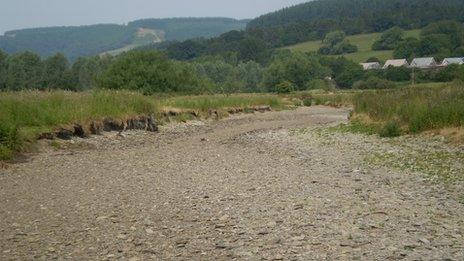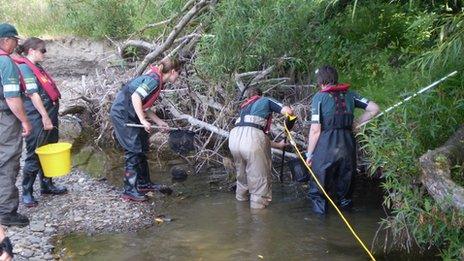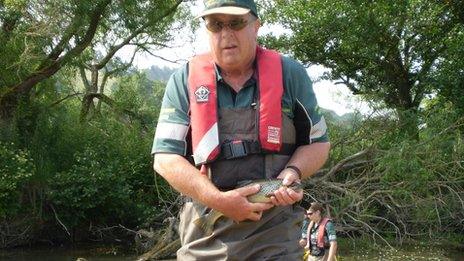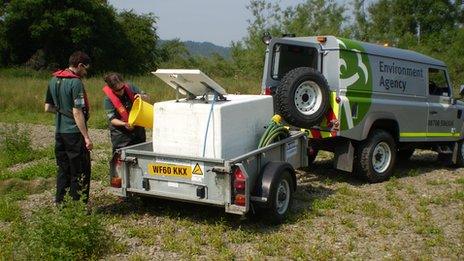River Teme fish rescued as water levels drop
- Published

The Environment Agency said the river has "been reduced to a few isolated pools"

The fish have been stunned using a light electric current

The fish in the Teme are an "important population", the agency said

The fish are gathered in nets and moved to oxygenated tanks
Fish have been rescued from a Herefordshire river after water levels dropped due to the dry weather.
The Environment Agency (EA) said parts of the River Teme near Leintwardine are now dry, with fish stranded in isolated pools.
There is a risk of the fish suffocating due to lack of oxygen, the agency said.
The fish have been stunned using a light electric current and moved to other parts of the river where there is deeper water, a spokesman said.
Falling river levels are a natural event and occur from time to time on this part of the Teme in the summer, according to the EA.
Dave Throup, from the EA, said: "Normally it would be three or four feet deep, and more than that when it's in flood, but now it's just been reduced to a few isolated pools."
He said the agency was monitoring other water courses in Shropshire and Herefordshire.
"We are watching some low flows on some of the tributaries of the Teme and also some of the tributaries of the Wye in Herefordshire are getting very low now," he said.
The fish stock in the Teme is an "important population", Mr Throup said, particularly some of the salmon species.
"It would be a great shame if we were to lose them," he added.
'A bit groggy'
The agency said electric probes are used by fisheries officers to stun the fish so they can be moved.
The probes send a very mild electric charge through the water and stun the fish for about 10 seconds.
The fish are then gathered in nets and moved to oxygenated tanks.
The operation is carried out from a boat or by someone wearing protective waders in shallow waters.
Stunning with an electric current is used because capture rates can be much higher than other methods, external such as netting - hundreds of fish can be caught at one time.
Only approved operators can use the equipment, which is described as very "fish-friendly", the EA said.
According to David Rogers, professor of freshwater biology at the University of Derby, very few fish die when electric shocks are used to move them.
"The fish recover quite quickly - it's like us going in for an operation and being anaesthetised and coming round afterwards, you feel a bit groggy," he said.
Another method used is called "seine netting", where a net is hung vertically in the water, the bottom held down by weights and the top buoyed by floats.
Fish are caught in the netting, which is drawn like a curtain across a sectioned-off area of a river or pond.
"Either method can catch masses of fish," said Mr Rogers.
- Published5 June 2012
- Published11 May 2012
- Published12 March 2012
- Published13 October 2011